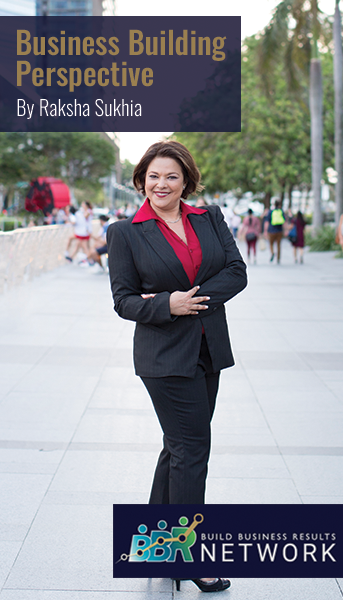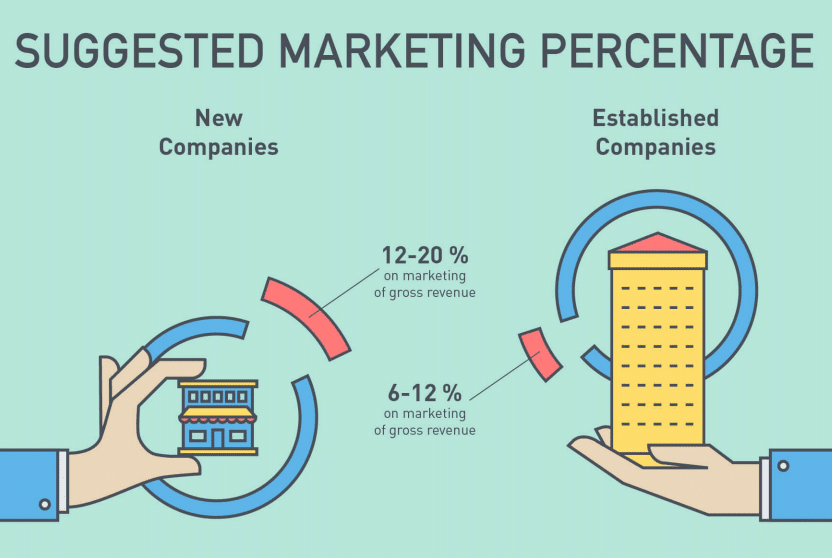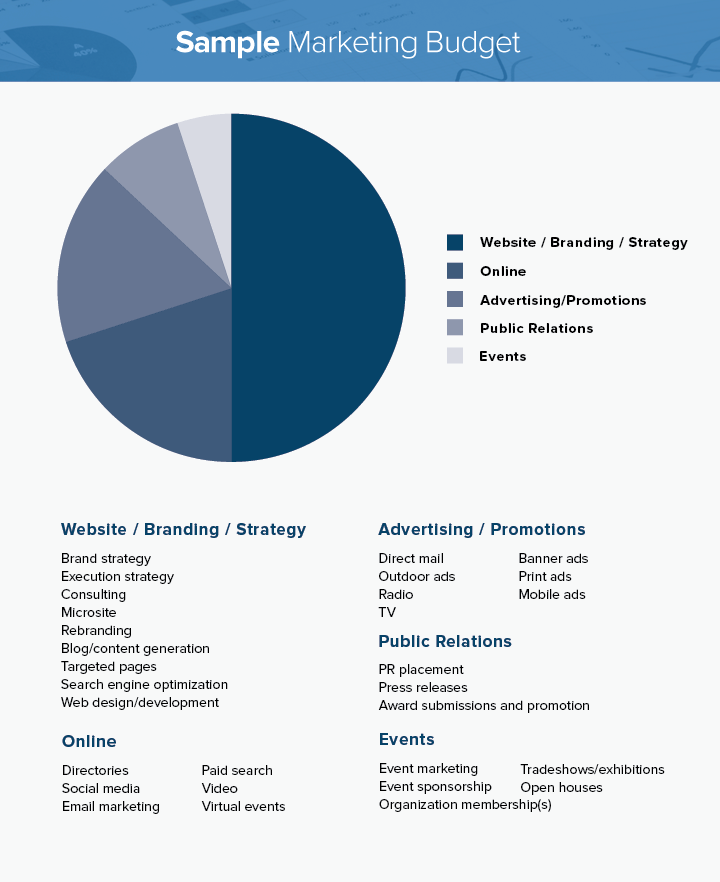How Much Should You Be Spending on Marketing?

Creating the perfect marketing budget has always been challenging. Without any doubt, the place and amount are two most important things marketers are concerned about. Remember, your budget will include all the marketing and advertising costs, public relations, transports, and many other things.
When it comes to marketing budgets, you must look at your current marketing foundations. Speding 2-5% of your sales revenue is always a good practice. In this article, there are references that will recommend you increase the percentage. Only then, should you be able to see the logic behind the 5% rule.
The writings illustrate what should be your key step as a marketer. You will start seeing marketing budget as a worthy investment for good marketers. With proper goals and targets set up, this will be the perfect time for you to start allocating budget for your marketing.
And if you want to Learn how to Leverage the Power of Direct Magnetic Marketing for Your Business, join our IGNITE Your 'Solo' or Small Business in 8 Weeks program.
See you on the action-field,
Raksha Sukhia, SMB Growth Expert,
Founder BBR Network. #bbrnetwork
As advisors for caterers and small business owners, we’re often asked how to create the right marketing budget.
As marketers, we’re frequently asked exactly where to invest that budget.
Here’s what we say:
The 5% Rule
To understand the recommendation, first, let’s define ‘marketing budget.’ Your marketing budget refers to all costs for marketing, advertising, public relations, promotions and anything else you might blanket under that very wide-cast net called ‘marketing’ on a day-to-day basis: for example, Google AdWords, social media, print ads, sponsorships, collateral and even tastings.
As you’ll see below, the ideal budget depends on your current marketing foundations. BUT, as a general rule based on the latest research, expert opinions and years of marketing experience, we say:
You should spend 2–5% of your sales revenue on marketing.
The U.S. Small Business Administration recommends spending 7 to 8 percent of your gross revenue for marketing and advertising if you’re doing less than $5 million a year in sales and your net profit margin—after all expenses—is in the 10 percent to 12 percent rang

Compared with those findings and the findings of many similar studies, 5% doesn’t seem that large of a number. In fact, it seems pretty reasonable.
But we should clarify that our 5% rule applies to most years, not all, and covers most of your marketing, but not all.
There will be times when you have to spend more to get what you want and need, but those are special projects. Let us explain!
Building Your Foundation
Years that require more spending will arise whenever you need to invest in the foundation for all of your day-to-day marketing activities.
For example, an up-to-date, performance-based website is key—perhaps the key—to a solid marketing foundation. Why? Your website is available for both showcasing and selling your marketing services 24/7.
You will likely have to exceed your 5% marketing budget to update your website once every three to five years. Thus, the marketing foundation costs are not typically included in your 5%.
In general, your marketing foundation includes:
- Brand
- Marketing strategy
- Website design and development
- Other things of this nature
Without a solid marketing foundation, your day-to-day marketing activities will range anywhere from “not very effective” to “a waste of money.”
Again, let’s use websites as an example.
We speak with many caterers and entrepreneurs who have websites generating less than 5,000 visitors per month—a perfectly respectable amount of traffic for many small businesses.

jackmonson.com
Scenario 1
Consider, though, if one of these websites was underperforming and converting only 1 in every 10,000 visitors into a customer (the conversion rate).
With 5,000 monthly visitors (which is on the high side for many caterers), a 1 in 10,000 conversion rate would translate to only one new online customer every two months.
If the owner of this website was investing $1,000 a month in online advertising, their cost to acquire each customer would be $2,000.
Scenario 2
Now consider an updated and conversion rate-optimized website—a website that converts every 1 in 500 visitors into a customer
With a 1 in 500 conversion rate, we’re talking about 10 new customers per month, with the same amount of traffic.
If the owner of this website was investing $1,000 a month in online advertising, their cost to acquire each customer would be $100.
That’s spending 95% less to acquire each new customer.
It’s not always that cut and dry, but we simplified this example to demonstrate why it’s almost always beneficial to exceed your 5% marketing budget for infrastructure investments.
How to Spend Your Marketing Budget
If you are marketing from a fairly static annual budget, you’re viewing marketing as an expense. Good marketers realize that it is an investment. – Seth Godin
Now that you understand the 5% rule and the importance of your marketing foundation, it’s time to talk about where to spend your budget.
1) Set Marketing Goals
The first step toward marketing budget allocation is determining your marketing goals for the year. We recommend at least three S.M.A.R.T. goals with predefined success measures tied to each.
Here are some common ones:
- Increase website traffic—measured by unique visitors per month
- Increase targeted leads to the website—measured by web visits from our geographic service area
- Grow new business or develop new division—measured by total leads and sales revenue
2) Check Your Marketing Foundation
Next, examine your marketing foundation. Do you have the foundation in place to reach your goals?
Check your brand, website, communication pieces and reporting systems. Questions to answer:
- Do you have a clear, up-to-date brand that properly identifies your company and consistently generates the same brand image for consumers?
- Does your brand have a consistent look and feel across all media?
- How does your website compare to the competition? Tip: Google “catering [your primary region/city]” e.g., “Catering Las Vegas,” and compare.
- Are there any barriers in your prospects’ path toward becoming customers?
- Do you have the tools and systems in place to measure the success of your marketing investment?
- Do you have a solid and solidified strategy for business development and marketing related to it?
3) Spend
With goals set and success measures in place, it’s time to allocate your marketing budget.
Your first priority is to remedy any weaknesses found in step two. Addressing weaknesses found in step two, more often than not, will be done with extra funding—marketing and/or business development funding—so you still have the full 5% of sales revenue to devote to day-to-day marketing activities.
Remember, both are necessary to launch your growth (with no traffic, even the best website in the world is worth very little).
Note: depending on the foundational weaknesses you identified, it may be best to limit day-to-day marketing activities until improvements are complete.
With goals set and a strong marketing foundation (including a marketing strategy), you’re ready to select marketing activities.
The figure below should be enough to get you started! It’s a sample marketing budget for a catering company. And while this example is catering-specific, the categories and activities themselves are adaptable to many industries.

Now it’s your turn. How much do you spend on marketing?
SignUp for Weekly Ezine
Related Article
What’s a Good Landing Page Conversion Rate?
Business Agility Is the New Norm. Do You Have What It Takes?
Tags
"23 closing techniques battlecard pdf", "audible", "best books on selling", "can anyone do sales", "how do you know you can sell", "how to sell a useless product", "how to sell anything book", "how to sell anything to anybody pdf", "how to sell anything to anyone anytime", "how to sell anything to anyone pdf", "how to sell without selling", "how to sell yourself", "i have a product how do i sell it", "Keyword", "marketing speech for selling a product", "retail selling tips", "sales success", "sell something to someone", "selling the right way", "sells marketing", "steps to sell anything", "street selling tips", "techniques to sell a product", "what to say to sell a product example", #BBR Network, #bbrnetwork, #Small Business Growth, Build Business Results (BBR) Network, business accelerator, business networking










